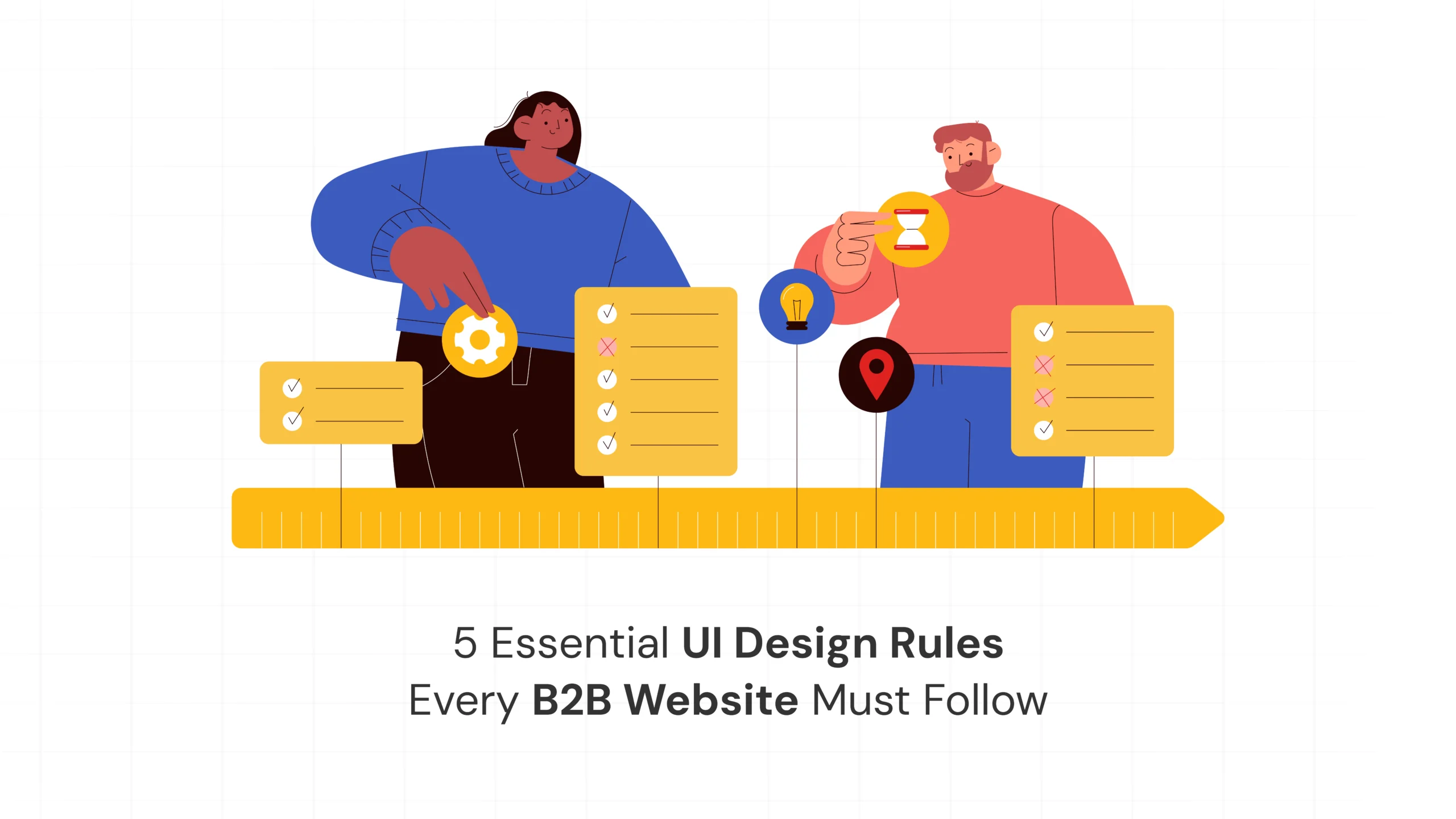
When it comes to the B2B UI design rules, many companies find less known how important the user interface is in trust, conversion, and long-term partnership. Unlike consumer-centric platforms, B2B sites should cater to decision-makers who value clarity, functionality, and professionalism. By 2025, the right design strategy can make all a difference between being another seller and becoming the leader of an industry.
5 Essential UI Design Rules Every B2B Website Must Follow
- September 11, 2025
- Ayesha J
- 10:00 am
When it comes to the B2B UI design rules, many companies find less known how important the user interface is in trust, conversion, and long-term partnership. Unlike consumer-centric platforms, B2B sites should cater to decision-makers who value clarity, functionality, and professionalism. By 2025, the right design strategy can make all a difference between being another seller and becoming the leader of an industry.
This article examines the five most important UI rules that each B2B website should follow, as well as providing actionable insights to help you refine your digital appearance.
1. Prioritize Simplicity and Clarity
B2B buyers frequently have a lot on their plates and don’t have time to sort through complicated websites. Well-defined typography, simple color schemes, and clean layouts all contribute to a straightforward user experience.
- Menus with straightforward navigation lighten the cognitive effort.
- Accessibility on all devices is improved with readable typefaces.
- Content finding is made simple by structured hierarchies.
Keep in mind that simplicity does not equate to boredom when using B2B website design best practices. It entails getting rid of friction.
2. Design for Decision-Makers, Not Casual Visitors
A B2B website isn’t an online store. It’s a hub for executives, procurement teams, and stakeholders looking for solutions. That’s why UI rules for B2B must emphasize authority and relevance.
- Emphasize case studies, endorsements, and ROI-producing outcomes.
- Make use of infographics and visualizations that are data-driven.
- Offer concise calls to action that are suited to the various phases of the consumer journey.
This user-centric design strategy makes decision-making faster, reducing bounce rates and increasing credibility.
3. Optimize for Mobile and Multi-Device Experiences
In today’s world, executives make decisions on the go. A responsive design isn’t optional—it’s mandatory. B2B UI design rules require:
- flexible designs that work well on PCs, tablets, and smartphones.
- Touch-friendly buttons and fast-loading pages are examples of mobile-first interactions.
- Smart caching and lightweight visuals for speed optimization.
Remember: first impressions are mobile impressions. A laggy mobile site signals inefficiency—something no B2B company wants to convey.
4. Consistency Across Brand Touchpoints
Compatibility is at the heart of trust. The B2B website Design Best Practices suggests that your user interface should reflect the brand identity at each touch point.
- Stick to frequent typography, color choices, and iconography.
- Adjust visible tone with brand reports.
- Form, dashboards, and portals ensure that the uniform pattern is followed.
Consistency creates confidentiality, and knowledge creates faith. This is one of the least powerful UI rules for B2B.
5. Balance Functionality with Aesthetics
Unlike B2C platforms, which can be bent heavily on visual appeal, B2B sites should have a delicate balance between design elegance and functional purposes.
- Avoid overload with animation or heavy graphics.
- Include modular scalability design systems.
- Use data visualization tools to simplify complex information.
The most successful B2B sites in 2025 mix beauty with utility. They affect without distracting and ensure that the design meets commercial goals.
Transform Your B2B Website with Expert UI Design
At Kavinu Designs, we create future-ready interfaces tailored for B2B success. Let’s build a website that inspires trust and drives results.
Latest Blogs
-
Why Calm Is the New Competitive Advantage in Digital Design (2026)31 Dec 2025
-
Why the Best Digital Experiences in 2025 Feel Effortless24 Dec 2025
-
The Digital Experience Playbook for 2025: UX, SEO, AI & Branding Explained Simply18 Dec 2025
-
The Future of Digital Branding: Why Emotion-Led Design Will Rule 202505 Dec 2025
-
How Gen Z Is Redefining Brand Experience Expectations in 202512 Nov 2025
Work With Us to Create Impactful Digital Experiences
FAQ
The most important B2B UI design rules include simplicity, decision-centered design, mobile accountability, stability, and balanced functionality with aesthetics. These rules ensure trust, clarity, and high conversion.
UI design is important because B2B sites should appeal to stakeholders to make high-value decisions. A poorly designed interface indicates unreliability, while a well-designed professionalism and rights.
Begin with a UX audit, bounded navigation, provide responsible design, use constant branding, and integrate data-driven images. The B2B website ensures the best practice after design that your site attracts and retains corporate.

